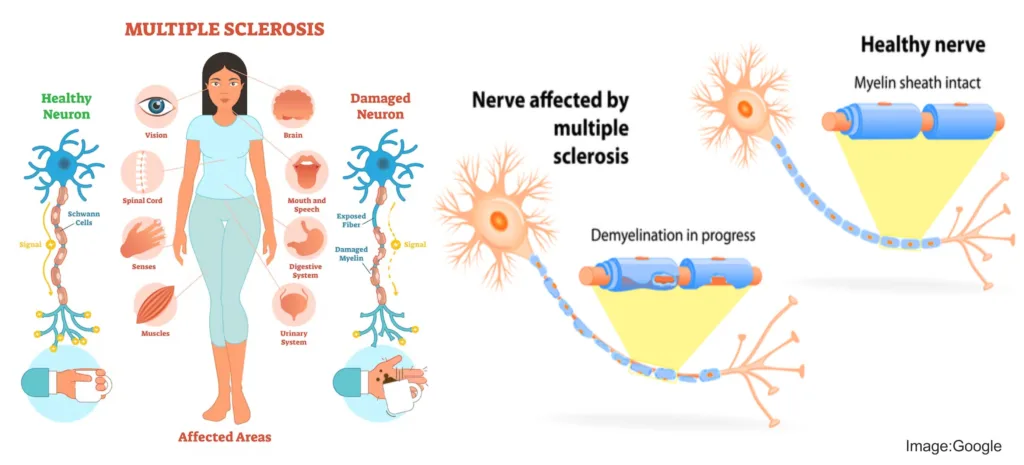Multiple Sclerosis (MS) is a disease that affects the central nervous system i.e. the spinal cord and brain. It has the potential to incapacitate a person. If a person has multiple sclerosis, the immune system goes on the offense against the myelin that protects nerve fibers. This results in problems with communication between the brain and the rest of the body. Over time, the disease causes degeneration of the nerves.
The vein may also be permanently damaged. The treatment of multiple sclerosis still eludes medical science. But treatments are available that speed patients’ recovery from attacks, keep symptoms within manageable limits and modify how the disease impacts a patient’s life. Below we will know more about Multiple Sclerosis Symptoms, Diagnose and Treatment.

Like its treatment, the cause of multiple sclerosis has not yet been determined. It is an autoimmune disease in which the myelin is under threat from the body’s own immune system. Myelin is similar to the coat of insulation on wires that conduct electricity. Nerves are vulnerable to damage and disability due to myelin damage. Why does sclerosis develop in some people? While the reason for saving other people from the exam is not yet clear. Scientists suspect a combination of genes and environment to be the cause of the disease.
Read Also : How Hosimoto’s Thyroid Effect Your Health?
What is Multiple Sclerosis?, Types of MS, Symptoms, Treatment Options, Dietary Considerations
1). Age: Although multiple sclerosis has been found in people of all ages between 16-60, it is especially seen in frail people.
2). Gender: This disease is twice more likely to affect women than men.
3). Genetics: If you have a sibling or parent who has multiple sclerosis, your risk of developing the disease is higher.
4). Medical conditions: Some infectious viruses have been found to be associated with multiple sclerosis. Certain autoimmune diseases such as type 1 diabetes, thyroid or inflammatory bowel disease increase the risk of developing the disease.
5). Ethnicity: White individuals, especially those of northern European descent, are at highest risk of developing the disease. African, Asian and Native American people are much less likely to develop the disease.
6). Climate: A temperate climate encourages the development of the disease. Smoking- Smokers are more prone to relapsing multiple sclerosis.
How Many Types of Multiple Sclerosis?

There are four types of Multiple Sclerosis –
1. Relapsing Remitting Multiple Sclerosis (RRMS).
This is the most common type of multiple sclerosis. People with RRMS have this over and over again on a temporary basis.
2. Secondary Progressive Multiple Sclerosis (SPMS).
In SPMS, symptoms get worse more rapidly over time. Most people who get RRMS also get SPMS.
3. Primary Progressive Multiple Sclerosis (PPMS).
This type of multiple sclerosis is not very common, occurring in about 10% of people with multiple sclerosis. In this, the symptoms gradually worsen from the beginning and it does not happen repeatedly.
4. Progressive Relapsing Multiple Sclerosis (PRMS).
This is a rare form of multiple sclerosis. In PRMS, the symptoms get progressively worse from the onset and it is recurrent and does not bring relief.
How much you aware for “Leukemia”
What are the Complications of MS?
People with multiple sclerosis are at risk of developing the following complications:
• Stiffness or spasm of the muscles.
• Paralysis especially in the legs.
• Bowel, bladder or sexual dysfunction.
• The disease can also trigger mental changes like forgetting things or mood swings.
• Epilepsy
• Depression

How to Diagnose Multiple Sclerosis?
Blood tests are done to find out whether the person is suffering from this disease or not. Balance, coordination, vision, and other activities are checked. Whole body MRI. Cerebrospinal fluid testing can diagnose the disease because specific proteins are usually found in the cerebrospinal fluid of a patient with multiple sclerosis.
What are the Symptoms of Multiple Sclerosis?
Its symptoms include weakness in the limbs, numbness of the body, sudden loss of balance, difficulty in seeing, etc. The patient becomes stressed. Special attention should be paid to food and diet in this disease. Learn what multiple sclerosis patients should eat and avoid.
• Weakness and numbness over one or both lymph nodes
• Complete or partial loss of vision
• Persistent Double Vision
• Pain all over the body
• Tingling on the body
• Slur
• Fatigue
Diet While Suffering MS (Multiple Sclerosis)?
1. Avoid Intake of Saturated Fat
If you have multiple sclerosis, avoid consuming saturated fat. It is present in the flesh of animals. This can cause cancer, heart disease and many health related problems.
2. Omega-3 and Omega-6 Fatty Acids
People suffering from this disease must include foods rich in omega-3 and omega-6 fatty acids in the diet. You will get omega-3 from salmon fish and omega-6 from dry fruits, sunflower oil.
TMJ – Temporomandibular Joint Disorder | Know About Treatment?
3. Green Leafy Vegetables
People who are overweight, as well as they are also struggling with this disease, then do not try to lose weight by consuming low-carb diet. Fatigue is felt more in this disease. If you will consume a low-carb diet, then there will be a severe lack of energy in the body. To get energy, consume plenty of fresh fruits, green leafy vegetables, whole grains.
4. Dairy Products
It would also be healthy for you to consume dairy products. If you want, you can consume low-fat dairy products. Drink and eat a lot of milk and curd. They are rich in calcium and vitamin D, which will keep your bones strong and protect you from multiple sclerosis. If you are suffering from MS, you can also strengthen your immunity through Vitamin D. Along with food, the sun’s rays are the main source of vitamin D.
5. Antioxidants
The more you include green and colorful vegetables in your diet, the more you can reduce the risk of multiple sclerosis. The antioxidants and vitamins in these vegetables nourish myelin (a type of nerve that is in the middle of the nervous system). Myelin is most commonly damaged in MS.
6. Fiber
Constipation is also more common in some people with multiple sclerosis. Actually, consumption of medicines causes constipation. In such a situation, to keep the stomach clean, digest food and avoid the problem of constipation, you should include more fiber in the food. If you consume fiber rich fruits and vegetables, then the complaint of constipation will go away.
7. Drink Juice
Apart from this, plenty of liquid things should also be consumed. Drink juices prepared from water, fruits and vegetables. This will also have many other benefits for health. Also, keep in touch with your doctor to keep the symptoms under control.
(Disclaimer : The purpose of this health-related article is to wake you up and aware of your health and to provide health-related information. Your doctor has a better understanding of your health and there is no substitute for their advice.)
F.A.Q. (Frequently Asked Questions)
Q.1 What is the main cause of multiple sclerosis?
Answer : The cause of multiple sclerosis is unknown. It’s considered an autoimmune disease in which the body’s immune system attacks its own tissues. In the case of MS , this immune system malfunction destroys the fatty substance that coats and protects nerve fibers in the brain and spinal cord (myelin).
Q.2 Who is at high risk for MS?
Answer : In the general population, the risk of developing MS is about 1 in 750-1000. What are other risk factors for MS? Evidence shows that low vitamin D levels, smoking and obesity all play important roles in the development of MS. Many viruses and bacteria have been or are being investigated in connection with MS as well.
Q.3 When should you suspect multiple sclerosis?
Answer : People should consider the diagnosis of MS if they have one or more of these symptoms: vision loss in one or both eyes. acute paralysis in the legs or along one side of the body. acute numbness and tingling in a limb.
Q.4 What are 5 symptoms of MS?
Answer : Below are some of the common symptoms of MS?
- fatigue.
- numbness and tingling.
- loss of balance and dizziness.
- stiffness or spasms.
- tremor.
- pain.
- bladder problems.
- bowel trouble.
Q.5 How is MS detected?
Answer : An MRI scanner uses a strong magnetic field to create a detailed image of inside your brain and spinal cord. It’s very accurate and can pinpoint the exact location and size of any inflammation, damage or scarring (lesions). MRI scans confirm a diagnosis in over 90 per cent of people with MS.
Q.6 How long do MS patients live?
Answer : Average life span of 25 to 35 years after the diagnosis of MS is made are often stated. Some of the most common causes of death in MS patients are secondary complications resulting from immobility, chronic urinary tract infections, compromised swallowing and breathing.